jump cable SMART FORTWO COUPE ELECTRIC DRIVE 2013 Owners Manual
[x] Cancel search | Manufacturer: SMART, Model Year: 2013, Model line: FORTWO COUPE ELECTRIC DRIVE, Model: SMART FORTWO COUPE ELECTRIC DRIVE 2013Pages: 218, PDF Size: 2.69 MB
Page 9 of 218
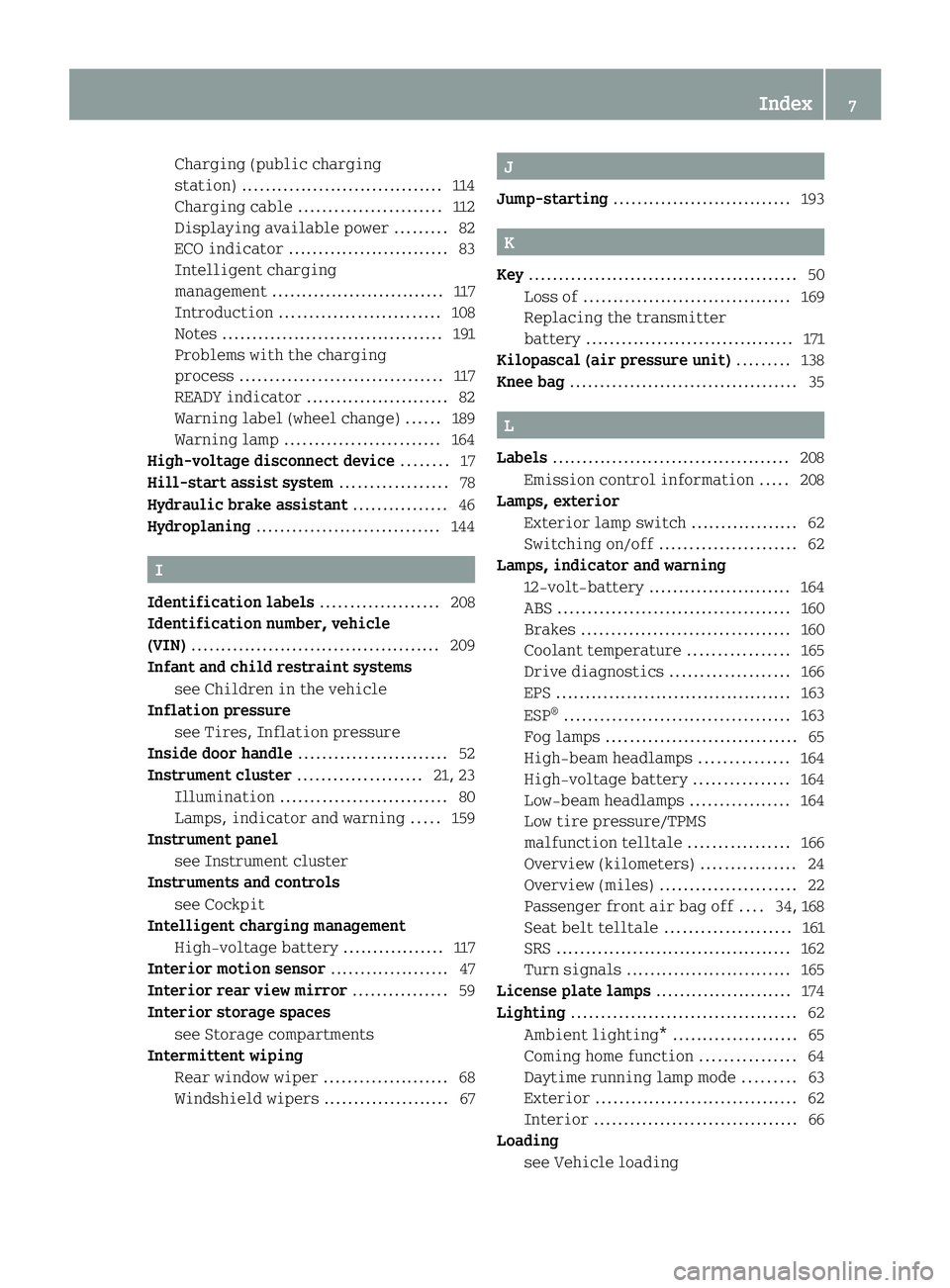
Charging (public charging
station)
.................................. 114
Charging cable ........................ 112
Displaying available power .........82
ECO indicator ........................... 83
Intelligen tcharging
management ............................. 117
Introduction ........................... 108
Notes ..................................... 191
Problems with the charging
process .................................. 117
READY indicator ........................ 82
Warning label (wheel change) ......189
Warnin glamp .......................... 164
High-voltage disconnect device ........17
Hill-start assist system ..................78
Hydraulic brake assistant ................46
Hydroplaning ............................... 144I
Identification labels ....................208
Identification number, vehicle
(VIN) .......................................... 209
Infant and child restraint systems see Children in the vehicle
Inflation pressure
see Tires, Inflation pressure
Inside door handle ......................... 52
Instrument cluster .....................21, 23
Illumination ............................ 80
Lamps, indicator and warnin g..... 159
Instrument panel
see Instrument cluster
Instruments and controls
see Cockpit
Intelligent charging management
High-voltage battery .................117
Interior motion sensor ....................47
Interior rear view mirror ................59
Interior storage spaces see Storage compartments
Intermittent wiping
Rear window wiper .....................68
Windshield wipers .....................67 J
Jump-starting .............................. 193 K
Key ............................................. 50
Loss of ................................... 169
Replacing the transmitter
battery ................................... 171
Kilopascal (air pressure unit) .........138
Knee bag ...................................... 35 L
Labels ........................................ 208
Emission control information .....208
Lamps, exterior
Exterior lamp switch ..................62
Switching on/off ....................... 62
Lamps, indicator and warning
12-volt-battery ........................ 164
ABS ....................................... 160
Brakes ................................... 160
Coolant temperature .................165
Drive diagnostics ....................166
EPS ........................................ 163
ESP ®
...................................... 163
Fog lamps ................................ 65
High-beam headlamps ...............164
High-voltage battery ................164
Low-beam headlamps .................164
Low tire pressure/TPMS
malfunction telltal e................. 166
Overview (kilometers) ................24
Overview (miles) ....................... 22
Passenger front air bag off ....34, 168
Seat belt telltale ..................... 161
SRS ....................................... .162
Turn signals ............................ 165
License plate lamps .......................174
Lighting ...................................... 62
Ambient lighting* .....................65
Coming home function ................64
Daytime running lamp mode .........63
Exterior .................................. 62
Interior .................................. 66
Loading
see Vehicle loading Index
7
Page 193 of 218
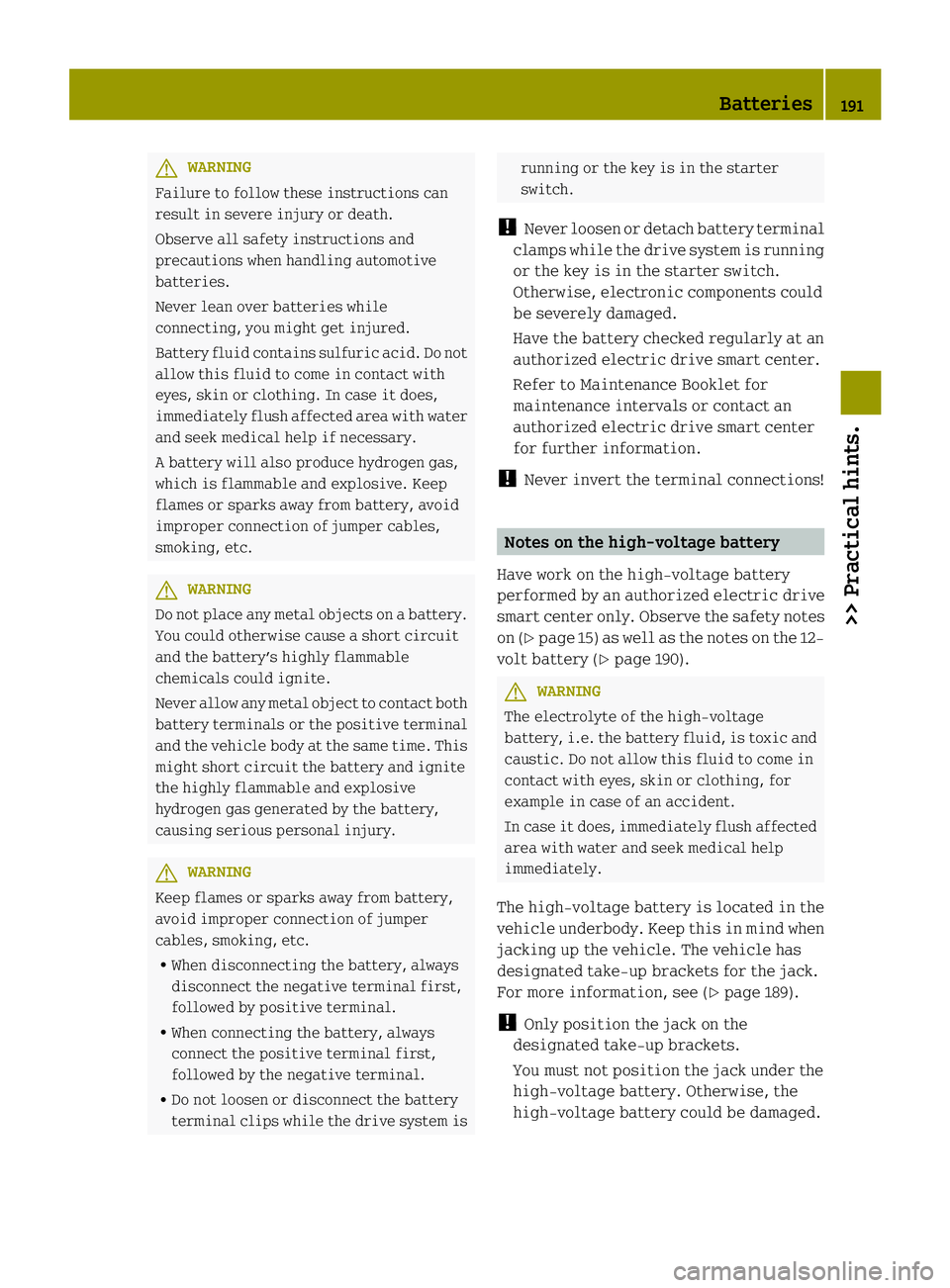
G
WARNING
Failure to follow these instructions can
result in severe injury or death.
Observe all safety instructions and
precautions when handling automotive
batteries.
Never lean over batteries while
connecting, you might get injured.
Batter yfluid contains sulfuric acid. Do not
allow this fluid to come in contact with
eyes, skin or clothing. In case it does,
immediately flush affected area with water
and seek medical help if necessary.
A battery will also produce hydrogen gas,
which is flammable and explosive. Keep
flames or sparks away from battery, avoid
improper connection of jumper cables,
smoking, etc. G
WARNING
Do not place any metal objects on a battery.
You could otherwise cause a short circuit
and the battery’s highly flammable
chemicals could ignite.
Never allow any metal object to contact both
battery terminals or the positive terminal
and the vehicle body at the same time. This
might short circuit the battery and ignite
the highly flammable and explosive
hydrogen gas generated by the battery,
causing serious personal injury. G
WARNING
Keep flames or sparks away from battery,
avoid improper connection of jumper
cables, smoking, etc.
R When disconnecting the battery, always
disconnect the negative terminal first,
followed by positive terminal.
R When connecting the battery, always
connect the positive terminal first,
followed by the negative terminal.
R Do not loosen or disconnect the battery
terminal clips while the drive system is running or the key is in the starter
switch.
! Never loosen or detach battery terminal
clamps while the drive system is running
or the key is in the starter switch.
Otherwise, electronic components could
be severely damaged.
Have the battery checked regularly at an
authorized electric drive smart center.
Refer to Maintenance Booklet for
maintenance intervals or contact an
authorized electric drive smart center
for further information.
! Never invert the terminal connections! Notes on the high‑voltage battery
Have work on the high-voltage battery
performed by an authorized electric drive
smart center only. Observe the safety notes
on (Y page 15) as well as the notes on the 12-
volt battery (Y page 190). G
WARNING
The electrolyte of the high-voltage
battery, i.e. the battery fluid, is toxic and
caustic. Do not allow this fluid to come in
contact with eyes, skin or clothing, for
example in case of an accident.
In case it does, immediately flush affected
area with water and seek medical help
immediately.
The high-voltage battery is located in the
vehicle underbody. Keep this in mind when
jacking up the vehicle. The vehicle has
designated take-up brackets for the jack.
For more information, see (Y page 189).
! Only position the jack on the
designated take-up brackets.
You must not position the jack under the
high-voltage battery. Otherwise, the
high-voltage battery could be damaged. Batteries
191>> Practical hints. Z
Page 195 of 218
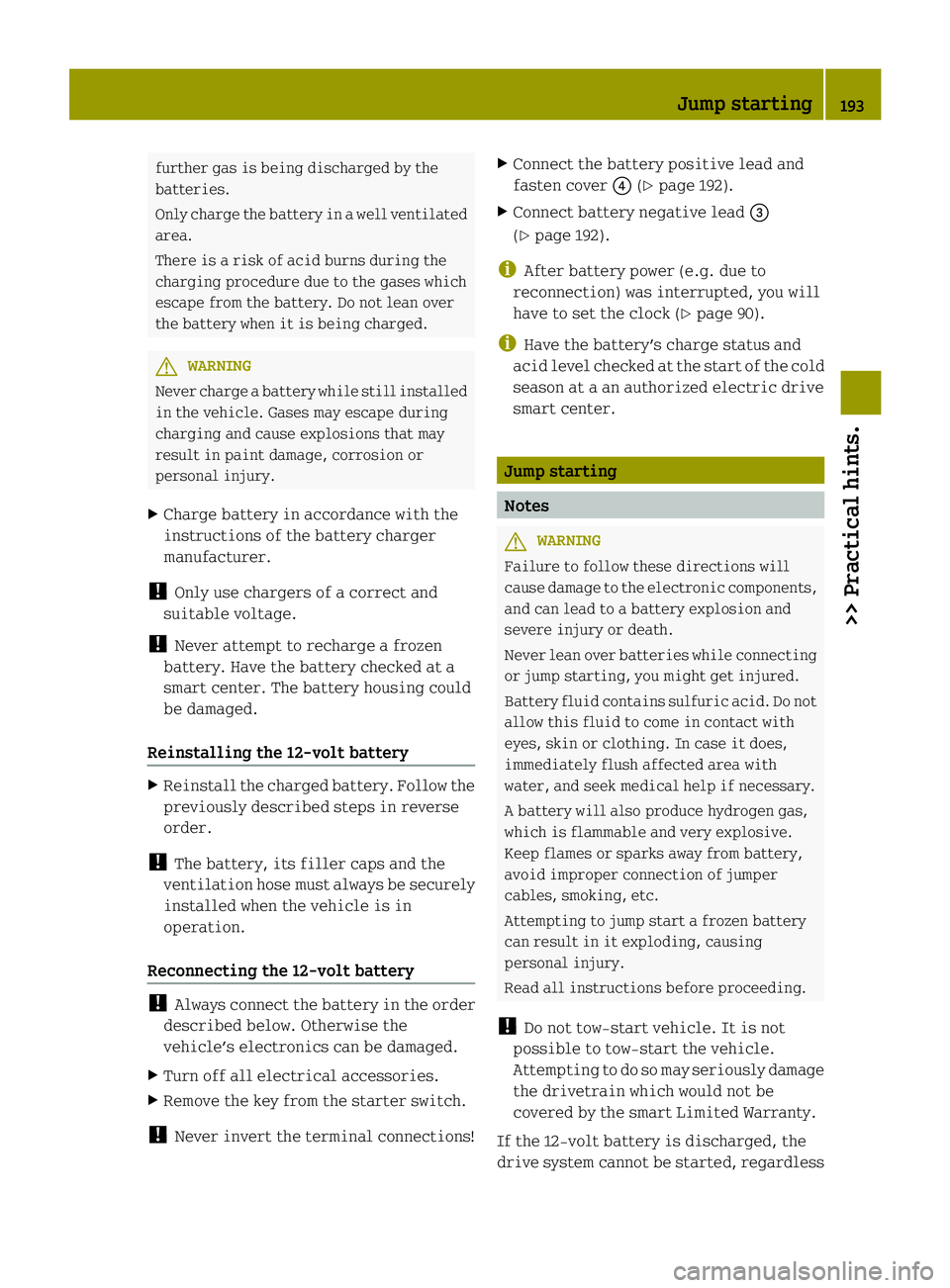
further gas is being discharged by the
batteries.
Only charge the battery in
awell ventilated
area.
There is a risk of acid burns during the
charging procedure due to the gases which
escape from the battery. Do not lean over
the battery when it is being charged. G
WARNING
Never charge a battery while still installed
in the vehicle. Gases may escape during
charging and cause explosions that may
result in paint damage, corrosion or
personal injury.
X Charge battery in accordance with the
instructions of the battery charger
manufacturer.
! Only use chargers of a correct and
suitable voltage.
! Never attempt to recharge a frozen
battery. Have the battery checked at a
smart center. The battery housing could
be damaged.
Reinstalling the 12-volt battery X
Reinstall the charged battery. Follow the
previously described steps in reverse
order.
! The battery, its filler caps and the
ventilation hose must always be securely
installed when the vehicle is in
operation.
Reconnecting the 12-volt battery !
Always connect the battery in the order
described below. Otherwise the
vehicle’s electronics can be damaged.
X Turn off all electrical accessories.
X Remove the key from the starter switch.
! Never invert the terminal connections! X
Connect the battery positive lead and
fasten cover 002A(Ypage 192).
X Connect battery negative lead 002B
(Y page 192).
i After battery power (e.g. due to
reconnection) was interrupted, you will
have to set the clock (Y page 90).
i Have the battery’s charge status and
acid level checked at the start of the cold
season at a an authorized electric drive
smart center. Jump starting
Notes
G
WARNING
Failure to follow these directions will
cause damage to the electronic components,
and can lead to a battery explosion and
severe injury or death.
Never lean over batteries while connecting
or jump starting, you might get injured.
Battery fluid contains sulfuric acid. Do not
allow this fluid to come in contact with
eyes, skin or clothing. In case it does,
immediately flush affected area with
water, and seek medical help if necessary.
A battery will also produce hydrogen gas,
which is flammable and very explosive.
Keep flames or sparks away from battery,
avoid improper connection of jumper
cables, smoking, etc.
Attempting to jump start a frozen battery
can result in it exploding, causing
personal injury.
Read all instructions before proceeding.
! Do not tow‑start vehicle. It is not
possible to tow-start the vehicle.
Attempting to do so may seriously damage
the drivetrain which would not be
covered by the smart Limited Warranty.
If the 12-volt battery is discharged, the
drive system cannot be started, regardless Jump starting
193>> Practical hints. Z
Page 196 of 218
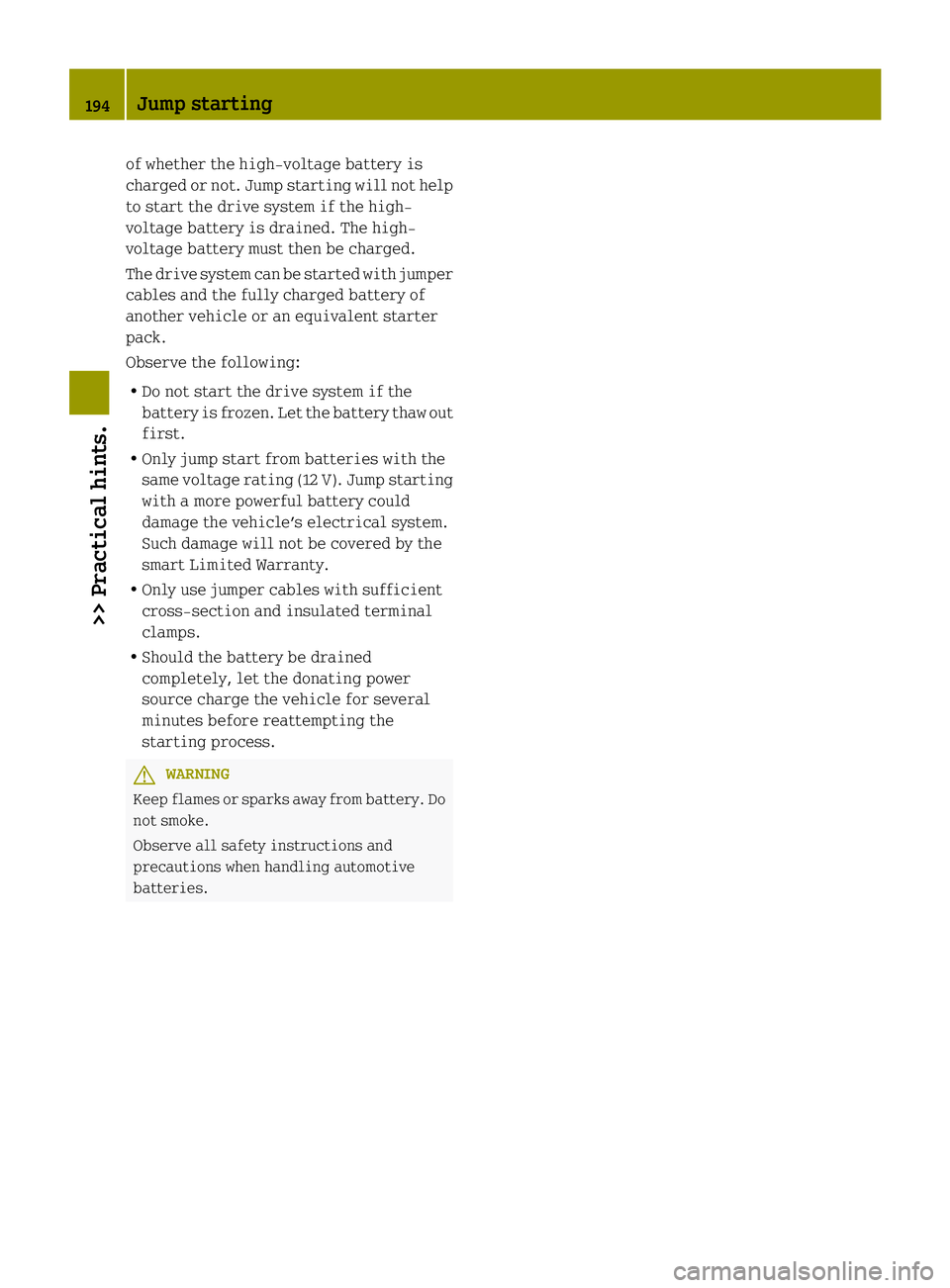
of whether the high-voltage battery is
charged or not. Jump starting will not help
to start the drive system if the high-
voltage battery is drained. The high-
voltage battery must then be charged.
The drive system can be started with jumper
cables and the fully charged battery of
another vehicle or an equivalent starter
pack.
Observe the following:
R Do not start the drive system if the
battery is frozen. Let the battery thaw out
first.
R Only jump start from batteries with the
same voltage rating (12 V). Jump starting
with a more powerful battery could
damage the vehicle’s electrical system.
Such damage will not be covered by the
smart Limited Warranty.
R Only use jumper cables with sufficient
cross-section and insulated terminal
clamps.
R Should the battery be drained
completely, let the donating power
source charge the vehicle for several
minutes before reattempting the
starting process. G
WARNING
Keep flames or sparks away from battery. Do
not smoke.
Observe all safety instructions and
precautions when handling automotive
batteries. 194
Jump starting>> Practical hints.
Page 197 of 218
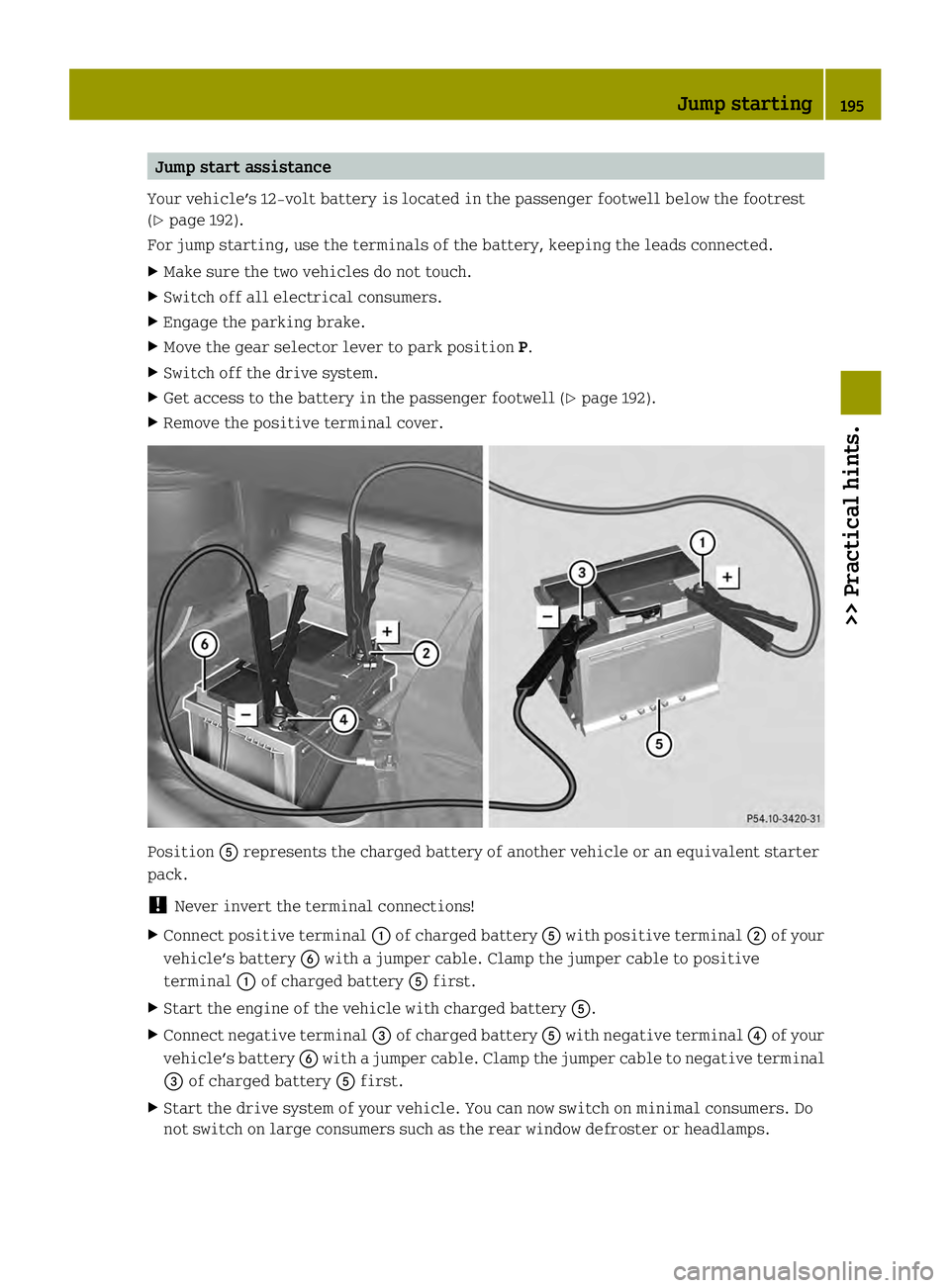
Jump start assistance
Your vehicle’s 12-volt battery is located in the passenger footwell below the footrest
(Y page 192).
For jump starting, use the terminals of the battery, keeping the leads connected.
X Make sure the two vehicles do not touch.
X Switch off all electrical consumers.
X Engage the parking brake.
X Move the gear selector lever to park position P.
X Switch off the drive system.
X Get access to the battery in the passenger footwell (Y page 192).
X Remove the positive terminal cover. Position
0028represents the charged battery of another vehicle or an equivalent starter
pack.
! Never invert the terminal connections!
X Connect positive terminal 0002of charged battery 0028with positive terminal 0003of your
vehicle’s battery 0029with a jumper cable. Clamp the jumper cable to positive
terminal 0002of charged battery 0028first.
X Start the engine of the vehicle with charged battery 0028.
X Connect negative terminal 002Bof charged battery 0028with negative terminal 002Aof your
vehicle’s battery 0029with a jumper cable. Clamp the jumper cable to negative terminal
002B of charged battery 0028first.
X Start the drive system of your vehicle. You can now switch on minimal consumers. Do
not switch on large consumers such as the rear window defroster or headlamps. Jump starting
195>> Practical hints. Z
Page 198 of 218
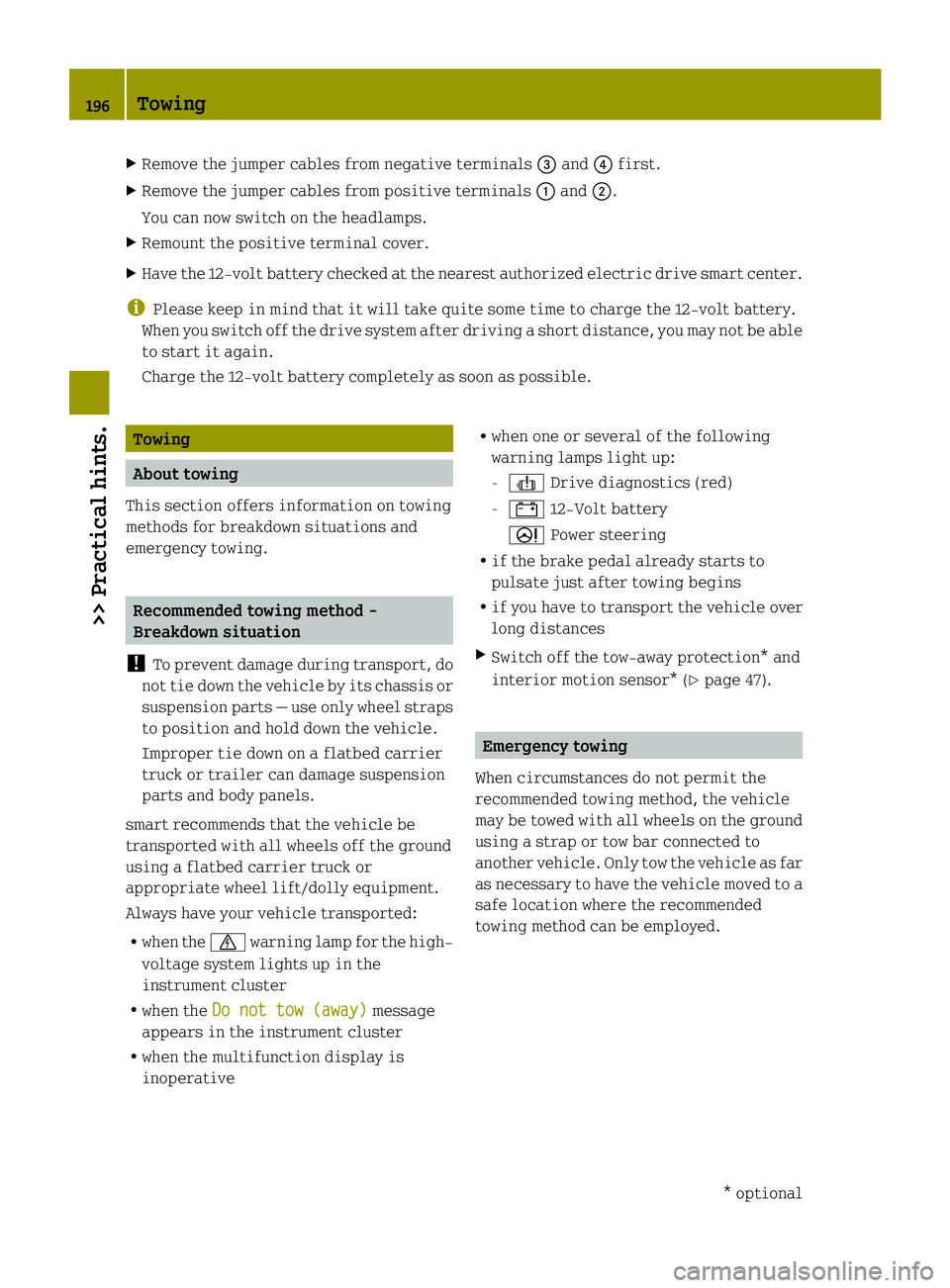
X
Remove the jumper cables from negative terminals 002Band 002Afirst.
X Remove the jumper cables from positive terminals 0002and 0003.
You can now switch on the headlamps.
X Remount the positive terminal cover.
X Have the 12-vol tbattery checked at the nearest authorized electric drive smart center.
i Please keep in mind that it will take quite some time to charge the 12-volt battery.
When you switch off the drive system after driving a short distance, you may not be able
to start it again.
Charge the 12-volt battery completely as soon as possible. Towing
About towing
This section offers information on towing
methods for breakdown situations and
emergency towing. Recommended towing method -
Breakdown situation
! To prevent damage during transport, do
not tie down the vehicle by its chassis or
suspension parts — use only wheel straps
to position and hold down the vehicle.
Improper tie down on a flatbed carrier
truck or trailer can damage suspension
parts and body panels.
smart recommends that the vehicle be
transported with all wheels off the ground
using a flatbed carrier truck or
appropriate wheel lift/dolly equipment.
Always have your vehicle transported:
R when the 0002warning lamp for the high-
voltage system lights up in the
instrument cluster
R when the Do not tow (away) message
appears in the instrument cluster
R when the multifunction display is
inoperative R
when one or several of the following
warning lamps light up:
-0001 Drive diagnostics (red)
- 0004 12‑Volt battery
0002 Power steering
R if the brake pedal already starts to
pulsate just after towing begins
R if you have to transport the vehicle over
long distances
X Switch off the tow‑away protection* and
interior motion sensor* (Y page 47). Emergency towing
When circumstances do not permit the
recommended towing method, the vehicle
may be towed with all wheels on the ground
using a strap or tow bar connected to
another vehicle. Only tow the vehicle as far
as necessary to have the vehicle moved to a
safe location where the recommended
towing method can be employed. 196
Towing>> Practical hints.
* optional